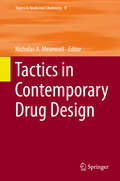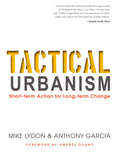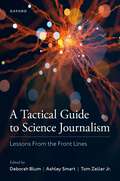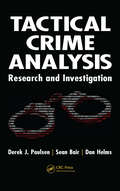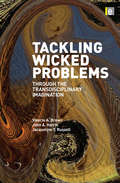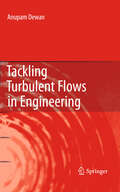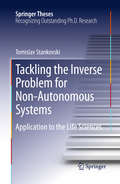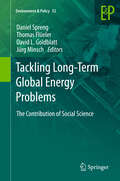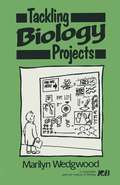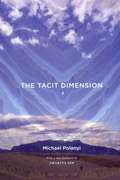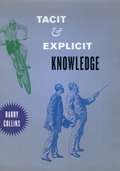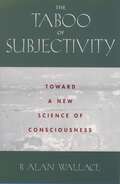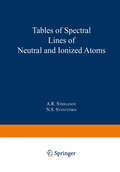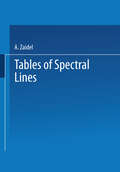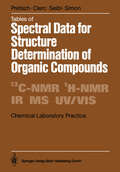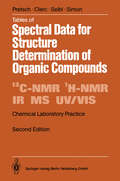- Table View
- List View
Tactics in Contemporary Drug Design (Topics in Medicinal Chemistry #12)
by Nicholas A. MeanwellMedicinal chemistry is both science and art. The science of medicinal chemistry offers mankind one of its best hopes for improving the quality of life. The art of medicinal chemistry continues to challenge its practitioners with the need for both intuition and experience to discover new drugs. Hence sharing the experience of drug research is uniquely beneficial to the field of medicinal chemistry. Drug research requires interdisciplinary team-work at the interface between chemistry, biology and medicine. Therefore, the topic-related series Topics in Medicinal Chemistry covers all relevant aspects of drug research, e.g. pathobiochemistry of diseases, identification and validation of (emerging) drug targets, structural biology, drugability of targets, drug design approaches, chemogenomics, synthetic chemistry including combinatorial methods, bioorganic chemistry, natural compounds, high-throughput screening, pharmacological in vitro and in vivo investigations, drug-receptor interactions on the molecular level, structure-activity relationships, drug absorption, distribution, metabolism, elimination, toxicology and pharmacogenomics. In general, special volumes are edited by well known guest editors.
Tactical Urbanism: Short-term Action For Long-term Change
by Mike Lydon Anthony GarciaShort-term, community-based projects—from pop-up parks to open streets initiatives—have become a powerful and adaptable new tool of urban activists, planners, and policy-makers seeking to drive lasting improvements in their cities and beyond. These quick, often low-cost, and creative projects are the essence of the Tactical Urbanism movement. Whether creating vibrant plazas seemingly overnight or re-imagining parking spaces as neighborhood gathering places, they offer a way to gain public and government support for investing in permanent projects, inspiring residents and civic leaders to experience and shape urban spaces in a new way.Tactical Urbanism, written by Mike Lydon and Anthony Garcia, two founders of the movement, promises to be the foundational guide for urban transformation. The authors begin with an in-depth history of the Tactical Urbanism movement and its place among other social, political, and urban planning trends, and a detailed set of case studies demonstrate the breadth and scalability of tactical urbanism interventions. Finally, the book provides a detailed toolkit for conceiving, planning, and carrying out projects, including how to adapt them based on local needs and challenges.Tactical Urbanism will inspire and empower a new generation of engaged citizens, urban designers, land use planners, architects, and policymakers to become key actors in the transformation of their communities.
A Tactical Guide to Science Journalism: Lessons From the Front Lines
by Ashley Smart And Tom Zeller Deborah Blum Jr.A Tactical Guide to Science Journalism brings together award-winning journalists from around the world to share fascinating tales of science and how it works and to provide guidance into reporting specialties like infectious disease, climate change, astronomy, public health, physics, and statistics. From practical advice on finding sources and distilling complex research subjects for a general audience, to tips on how to cover science in authoritarian regimes, the book serves as an essential survey of the best in science reporting today--and a testament to the importance of independent journalistic inquiry in understanding research and building trust with audiences. Drawing insights from writers based at publications including The New York Times, the BBC, The Washington Post, Science, The New Yorker, National Geographic and more, this guide is designed to help journalists everywhere improve their craft and serve as a valuable resource for those seeking to understand the profession at its best.
A Tactical Guide to Science Journalism: Lessons From the Front Lines
A Tactical Guide to Science Journalism brings together award-winning journalists from around the world to share fascinating tales of science and how it works and to provide guidance into reporting specialties like infectious disease, climate change, astronomy, public health, physics, and statistics. From practical advice on finding sources and distilling complex research subjects for a general audience, to tips on how to cover science in authoritarian regimes, the book serves as an essential survey of the best in science reporting today--and a testament to the importance of independent journalistic inquiry in understanding research and building trust with audiences. Drawing insights from writers based at publications including The New York Times, the BBC, The Washington Post, Science, The New Yorker, National Geographic and more, this guide is designed to help journalists everywhere improve their craft and serve as a valuable resource for those seeking to understand the profession at its best.
Tactical Crime Analysis: Research and Investigation
by Derek J. PaulsenResearch has shown that the majority of crimes are committed by persistent or serial offenders, with as little as seven percent of offenders accounting for approximately 60 percent of all crimes. By focusing police efforts on these prolific offenders and learning to identify, analyze, and resolve the crimes they commit, the law enforcement communit
Tackling Wicked Problems: Through the Transdisciplinary Imagination
by John Harris Valerie A Brown Jacqueline RussellFrom climate change to GM foods, we are increasingly confronted with complex, interconnected social and environmental problems that span disciplines, knowledge bases and value systems. This book offers a transdisciplinary, open approach for those working towards resolving these 'wicked' problems and highlights the crucial role of this 'transdisciplinary imagination' in addressing the shift to sustainable futures. Tackling Wicked Problems provides readers with a framework and practical examples that will guide the design and conduct of their own open-ended enquiries. In this approach, academic disciplines are combined with personal, local and strategic understanding and researchers are required to recognise multiple knowledge cultures, accept the inevitability of uncertainty, and clarify their own and others' ethical positions. The authors then comment on fifteen practical examples of how researchers have engaged with the opportunities and challenges of conducting transdisciplinary inquiries. The book gives those who are grappling with complex problems innovative methods of inquiry that will allow them to work collaboratively towards long-term solutions.
Tackling Wicked Problems: Through the Transdisciplinary Imagination
by John Harris Valerie A Brown Jacqueline RussellFrom climate change to GM foods, we are increasingly confronted with complex, interconnected social and environmental problems that span disciplines, knowledge bases and value systems. This book offers a transdisciplinary, open approach for those working towards resolving these 'wicked' problems and highlights the crucial role of this 'transdisciplinary imagination' in addressing the shift to sustainable futures. Tackling Wicked Problems provides readers with a framework and practical examples that will guide the design and conduct of their own open-ended enquiries. In this approach, academic disciplines are combined with personal, local and strategic understanding and researchers are required to recognise multiple knowledge cultures, accept the inevitability of uncertainty, and clarify their own and others' ethical positions. The authors then comment on fifteen practical examples of how researchers have engaged with the opportunities and challenges of conducting transdisciplinary inquiries. The book gives those who are grappling with complex problems innovative methods of inquiry that will allow them to work collaboratively towards long-term solutions.
Tackling Turbulent Flows in Engineering
by Anupam DewanThe emphasis of this book is on engineering aspects of fluid turbulence. The book explains for example how to tackle turbulence in industrial applications. It is useful to several disciplines, such as, mechanical, civil, chemical, aerospace engineers and also to professors, researchers, beginners, under graduates and post graduates. The following issues are emphasized in the book: - Modeling and computations of engineering flows: The author discusses in detail the quantities of interest for engineering turbulent flows and how to select an appropriate turbulence model; Also, a treatment of the selection of appropriate boundary conditions for the CFD simulations is given. - Modeling of turbulent convective heat transfer: This is encountered in several practical situations. It basically needs discussion on issues of treatment of walls and turbulent heat fluxes. - Modeling of buoyancy driven flows, for example, smoke issuing from chimney, pollutant discharge into water bodies, etc
Tackling the Inverse Problem for Non-Autonomous Systems: Application to the Life Sciences (Springer Theses)
by Tomislav StankovskiThis thesis presents a new method for following evolving interactions between coupled oscillatory systems of the kind that abound in nature. Examples range from the subcellular level, to ecosystems, through climate dynamics, to the movements of planets and stars. Such systems mutually interact, adjusting their internal clocks, and may correspondingly move between synchronized and non-synchronized states. The thesis describes a way of using Bayesian inference to exploit the presence of random fluctuations, thus analyzing these processes in unprecedented detail. It first develops the basic theory of interacting oscillators whose frequencies are non-constant, and then applies it to the human heart and lungs as an example. Their coupling function can be used to follow with great precision the transitions into and out of synchronization. The method described has the potential to illuminate the ageing process as well as to improve diagnostics in cardiology, anesthesiology and neuroscience, and yields insights into a wide diversity of natural processes.
Tackling Long-Term Global Energy Problems: The Contribution of Social Science (Environment & Policy #52)
by Daniel Spreng, Thomas Flüeler, David L. Goldblatt and Jürg MinschThis book makes a case for a multidisciplinary and transdisciplinary approach to energy research—one that brings more of the social sciences to bear. Featuring eight studies from across the spectrum of the social sciences, each applying multiple disciplines to one or more energy-related problems, the book demonstrates the strong analytical and policy-making potential of such a broadened perspective. Case studies include: energy transitions of households in developing countries, the ‘curse of oil’, politics and visions for renewables, economics and ethics in emissions trading, and carbon capture and storage.
The Tacit Dimension
by Michael Polanyi“I shall reconsider human knowledge by starting from the fact that we can know more than we can tell,” writes Michael Polanyi, whose work paved the way for the likes of Thomas Kuhn and Karl Popper. The Tacit Dimension argues that tacit knowledge—tradition, inherited practices, implied values, and prejudgments—is a crucial part of scientific knowledge. Back in print for a new generation of students and scholars, this volume challenges the assumption that skepticism, rather than established belief, lies at the heart of scientific discovery. “Polanyi’s work deserves serious attention. . . . [This is a] compact presentation of some of the essentials of his thought.”—Review of Metaphysics “Polanyi’s work is still relevant today and a closer examination of this theory that all knowledge has personal and tacit elements . . . can be used to support and refute a variety of widely held approaches to knowledge management.”—Electronic Journal of Knowledge "The reissuing of this remarkable book give us a new opportunity to see how far-reaching—and foundational—Michael Polanyi's ideas are, on some of the age-old questions in philosophy."—Amartya Sen, from the new Foreword
Tacit and Explicit Knowledge
by Harry CollinsMuch of what humans know we cannot say. And much of what we do we cannot describe. For example, how do we know how to ride a bike when we can’t explain how we do it? Abilities like this were called “tacit knowledge” by physical chemist and philosopher Michael Polanyi, but here Harry Collins analyzes the term, and the behavior, in much greater detail, often departing from Polanyi’s treatment. In Tacit and Explicit Knowledge, Collins develops a common conceptual language to bridge the concept’s disparate domains by explaining explicit knowledge and classifying tacit knowledge. Collins then teases apart the three very different meanings, which, until now, all fell under the umbrella of Polanyi’s term: relational tacit knowledge (things we could describe in principle if someone put effort into describing them), somatic tacit knowledge (things our bodies can do but we cannot describe how, like balancing on a bike), and collective tacit knowledge (knowledge we draw that is the property of society, such as the rules for language). Thus, bicycle riding consists of some somatic tacit knowledge and some collective tacit knowledge, such as the knowledge that allows us to navigate in traffic. The intermixing of the three kinds of tacit knowledge has led to confusion in the past; Collins’s book will at last unravel the complexities of the idea. Tacit knowledge drives everything from language, science, education, and management to sport, bicycle riding, art, and our interaction with technology. In Collins’s able hands, it also functions at last as a framework for understanding human behavior in a range of disciplines.
Tacit and Explicit Knowledge
by Harry CollinsMuch of what humans know we cannot say. And much of what we do we cannot describe. For example, how do we know how to ride a bike when we can’t explain how we do it? Abilities like this were called “tacit knowledge” by physical chemist and philosopher Michael Polanyi, but here Harry Collins analyzes the term, and the behavior, in much greater detail, often departing from Polanyi’s treatment. In Tacit and Explicit Knowledge, Collins develops a common conceptual language to bridge the concept’s disparate domains by explaining explicit knowledge and classifying tacit knowledge. Collins then teases apart the three very different meanings, which, until now, all fell under the umbrella of Polanyi’s term: relational tacit knowledge (things we could describe in principle if someone put effort into describing them), somatic tacit knowledge (things our bodies can do but we cannot describe how, like balancing on a bike), and collective tacit knowledge (knowledge we draw that is the property of society, such as the rules for language). Thus, bicycle riding consists of some somatic tacit knowledge and some collective tacit knowledge, such as the knowledge that allows us to navigate in traffic. The intermixing of the three kinds of tacit knowledge has led to confusion in the past; Collins’s book will at last unravel the complexities of the idea. Tacit knowledge drives everything from language, science, education, and management to sport, bicycle riding, art, and our interaction with technology. In Collins’s able hands, it also functions at last as a framework for understanding human behavior in a range of disciplines.
Tacit and Explicit Knowledge
by Harry CollinsMuch of what humans know we cannot say. And much of what we do we cannot describe. For example, how do we know how to ride a bike when we can’t explain how we do it? Abilities like this were called “tacit knowledge” by physical chemist and philosopher Michael Polanyi, but here Harry Collins analyzes the term, and the behavior, in much greater detail, often departing from Polanyi’s treatment. In Tacit and Explicit Knowledge, Collins develops a common conceptual language to bridge the concept’s disparate domains by explaining explicit knowledge and classifying tacit knowledge. Collins then teases apart the three very different meanings, which, until now, all fell under the umbrella of Polanyi’s term: relational tacit knowledge (things we could describe in principle if someone put effort into describing them), somatic tacit knowledge (things our bodies can do but we cannot describe how, like balancing on a bike), and collective tacit knowledge (knowledge we draw that is the property of society, such as the rules for language). Thus, bicycle riding consists of some somatic tacit knowledge and some collective tacit knowledge, such as the knowledge that allows us to navigate in traffic. The intermixing of the three kinds of tacit knowledge has led to confusion in the past; Collins’s book will at last unravel the complexities of the idea. Tacit knowledge drives everything from language, science, education, and management to sport, bicycle riding, art, and our interaction with technology. In Collins’s able hands, it also functions at last as a framework for understanding human behavior in a range of disciplines.
The Taboo of Subjectivity: Toward a New Science of Consciousness
by B. Alan WallaceThis book takes a bold new look at ways of exploring the nature, origins, and potentials of consciousness within the context of science and religion. Alan Wallace draws careful distinctions between four elements of the scientific tradition: science itself, scientific realism, scientific materialism, and scientism. Arguing that the metaphysical doctrine of scientific materialism has taken on the role of ersatz-religion for its adherents, he traces its development from its Greek and Judeo-Christian origins, focusing on the interrelation between the Protestant Reformation and the Scientific Revolution. He looks at scientists' long term resistance to the firsthand study of consciousness and details the ways in which subjectivity has been deemed taboo within the scientific community. In conclusion, Wallace draws on William James's idea for a "science of religion" that would study the nature of religious and, in particular, contemplative experience. In exploring the nature of consciousness, this groundbreaking study will help to bridge the chasm between religious belief and scientific knowledge. It is essential reading for philosophers and historians of science, scholars of religion, and anyone interested in the relationship between science and religion.
The Taboo of Subjectivity: Toward a New Science of Consciousness
by B. Alan WallaceThis book takes a bold new look at ways of exploring the nature, origins, and potentials of consciousness within the context of science and religion. Alan Wallace draws careful distinctions between four elements of the scientific tradition: science itself, scientific realism, scientific materialism, and scientism. Arguing that the metaphysical doctrine of scientific materialism has taken on the role of ersatz-religion for its adherents, he traces its development from its Greek and Judeo-Christian origins, focusing on the interrelation between the Protestant Reformation and the Scientific Revolution. He looks at scientists' long term resistance to the firsthand study of consciousness and details the ways in which subjectivity has been deemed taboo within the scientific community. In conclusion, Wallace draws on William James's idea for a "science of religion" that would study the nature of religious and, in particular, contemplative experience. In exploring the nature of consciousness, this groundbreaking study will help to bridge the chasm between religious belief and scientific knowledge. It is essential reading for philosophers and historians of science, scholars of religion, and anyone interested in the relationship between science and religion.
Tables of Spectral Lines of Neutral and Ionized Atoms
by A. R. Striganov N. S. SventitskiiTables of Spectral Lines of Neutral and Ionized Atoms was first published in Moscow in 1966. All misprints and errors that have come to our attention have been corrected, and additions based on journal articles have been made for the Plenum Press edition. In particular, additions have been made in the tables for Li (4], C I [1], N I (1], N IV [12], and N V [14]. Such highly important spectra as those of N IV, NV, 0 IV, 0 V, and 0 VI in the visible and partially in the ultraviolet regions have, until recently, re ceived almost no attention in the laboratory. The tables of these spectra in clude astrophysical data from B. Edlen (Z. Astrophys. , 7:378, 1933) and C. E. Moore (A Multiplet Table of Astrophysical Interest, Part I, N. B. S. , 1945) with rather rough estimates of the wavelengths of the spectral lines. But as the spectra of highly ionized atoms have been studied in the laboratory, these values have been determined more precisely, and we have striven to incorporate them in the American edition of the book. For the spectra of N IV and NV, we have employed the recent, comprehensive papers of R. Hallin (Arkiv for Fysik, 32:201, 1966; 31:511, 1966), in which the system of energy levels was refined and expanded, and many classified lines in the visible, ordinary ultra violet, and vacuum ultraviolet regions are cited.
Tables of Spectral Lines
by A. Zaidel'The broad development of spectroscopy in our country and, in particular, the extensive industrial applications of methods of spectral analysis make the need for basic reference literature a pressing one. Tables of spectral lines, as basic, primary material necessary for the identifica tion of spectra, are the most important of these reference books. The need for such tables is acutely felt by all who work in spectroscopy, and numerous requests for such a book have been received by the Commission on Spectroscopy of the Academy of Sciences of the USSR. On the world book market there are fairly complete tables that cover a very great number of spectral lines and that have been complied rather carefully, although they are not free of errors. Tables of this kind are undoubtedly necessary in general spectroscopic research and must be included among the reference books of large scientific institutions. But the number of workers who need such complete tables is comparatively limited. Therefore, after long discussion it was deemed impractical to republish these tables.
Tables of Spectral Data for Structure Determination of Organic Compounds (Chemical Laboratory Practice)
by Ernö Pretsch T. Clerc J. Seibl W. SimonAlthough numerical data are, in principle, universal, the compilations presented in this book are extensively annotated and interleaved with text. This translation of the second German edition has been prepared to facilitate the use of this work, with all its valuable detail, by the large community of English-speaking scientists. Translation has also provided an opportunity to correct and revise the text, and to update the nomenclature. Fortunately, spectroscopic data and their relationship with structure do not change much with time so one can predict that this book will, for a long period of time, continue to be very useful to organic chemists involved in the identification of organic compounds or the elucidation of their structure. Klaus Biemann Cambridge, MA, April 1983 Preface to the First German Edition Making use of the information provided by various spectroscopic tech niques has become a matter of routine for the analytically oriented organic chemist. Those who have graduated recently received extensive training in these techniques as part of the curriculum while their older colleagues learned to use these methods by necessity. One can, therefore, assume that chemists are well versed in the proper choice of the methods suitable for the solution of a particular problem and to translate the experimental data into structural information.
Tables of Spectral Data for Structure Determination of Organic Compounds (Chemical Laboratory Practice)
by Ernö Pretsch Thomas Clerc Joseph Seibl Wilhelm SimonAlthough numerical data are, in principle, universal, the compilations presented in this book are extensively annotated and interleaved with text. This translation of the second German edition has been prepared to facilitate the use of this work, with all its valuable detail, by the large community of English-speaking scientists. Translation has also provided an opportunity to correct and revise the text, and to update the nomenclature. Fortunately, spectroscopic data and their relationship with structure do not change much with time so one can predict that this book will, for a long period of time, continue to be very useful to organic chemists involved in the identification of organic compounds or the elucidation of their structure. Klaus Biemann Cambridge, MA, April 1983 Preface to the First German Edition Making use of the information provided by various spectroscopic tech niques has become a ·matter of routine for the analytically oriented organic chemist. Those who have graduated recently received extensive training in these techniques as part of the curriculum while their older colleagues learned to use these methods by necessity. One can, therefore, assume that chemists are well versed in the proper choice of the methods suitable for the solution of a particular problem and to translate the experimental data into structural information.
Tables of Coefficients for the Analysis of Triple Angular Correlations of Gamma-Rays from Aligned Nuclei
by G. Roland Kaye E.J.C. Read J.C. WillmottTables of Coefficients for the Analysis of Triple Angular Correlations of Gamma-Rays from Aligned Nuclei presents illustrations and discussions of such tables. The book discusses direction-direction triple correlation measurements as well as polarization-direction correlation measurements. The text also covers integral and half-integral tables. Lecturers and students of physics will find the book invaluable.
Tables for ascertaining the Density of American Mineral-Oils and their products by means of the Thermo-Areometer
by Imperial German Standards CommissionTable of Planets distances from the Sun and relative sizes (UEB Uncontracted)
This page shows a table of the planets of the Solar System, their distance from the Sun and their diameters. There is a locator dot shown, which will be at the top left of the page when the image is the correct way up. The table has five columns and ten rows. The planets names are in the far left column and to the right of this are their distances from the Sun in millions of miles and millions of kilometres, and their diameters in miles and kilometres.
Table of Planets distances from the Sun and relative sizes (UEB Contracted)
This page shows a table of the planets of the Solar System, their distance from the Sun and their diameters. There is a locator dot shown, which will be at the top left of the page when the image is the correct way up. The table has five columns and ten rows. The planets names are in the far left column and to the right of this are their distances from the Sun in millions of miles and millions of kilometres, and their diameters in miles and kilometres.
